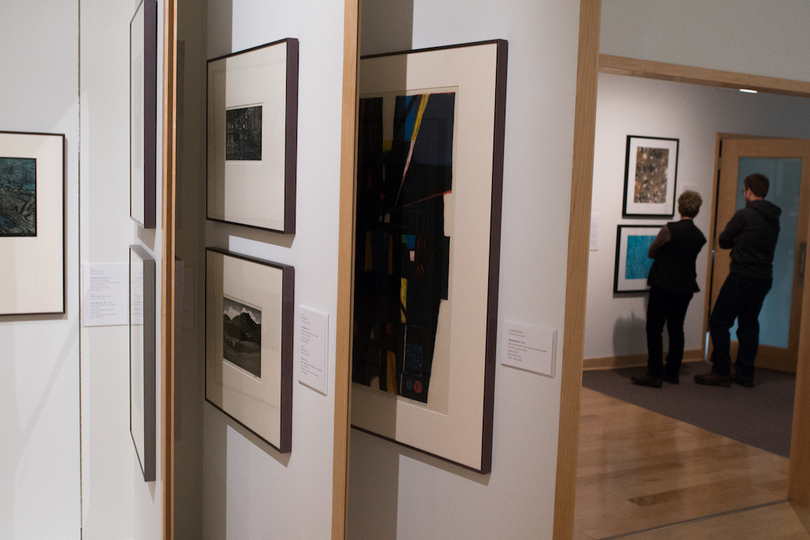How SUArt Galleries is painting broader horizons for students

Daily Orange File Photo
SU Art Galleries is increasingly encouraging professors and students alike to take their studies from the classroom into the art room.
UPDATED: Aug. 28, 2018 at 5:10 p.m.
Professor Kathryn Everly is a familiar face at the SUArt Galleries — Syracuse University’s fine arts museum — and is often accompanied by her students. She’ll show them prints of etchings forged by Francisco Goya, the most celebrated Spanish painter of the late 18th and early 19th centuries. She uses the artwork as a tool to explain to her students their thematic elements, as well as how they reflect similar themes discussed in her Spanish literature class.
Last semester, Everly struck a deal with her students: if they attended a guided exhibition tour led by David L. Prince, the gallery’s Associate Director and Curator of Collections, and wrote about it, they would receive extra credit.
To her surprise, two students, who she thought had no interest in the class, attended and submitted great essays.
“You don’t know whom you’re reaching,” she said. “Some people really relate better to a visual representation, a visual piece of art.”
In the past few years, the galleries have reached out to professors across the university, promoting the shows on display and how they connect to the subjects taught in the professors’ classes.
This semester’s “Rodin: The Human Experience,” a 31-piece traveling show of the revolutionary turn-of-the-century sculptor’s work, is as much a classroom as it is a show.
But it wasn’t always this way. SUArt Galleries didn’t exist 30 years ago. When David Prince came to SU as a graduate student in 1981, all of the university’s art collection was in storage, with no gallery space available for people to view it.

Anna Henderson | Digital Design Editor
SUArt Galleries’ exhibition space currently stands on land that used to be a dining hall attached to Sims Hall, SU’s oldest dormitory, that is now home to the Department of Public Safety. Four years ago, SUArt Galleries remodeled the gallery space in Shaffer Art Building, turning an open-view storage space into a permanent collections gallery.
Prince said he believes students can benefit from learning about the artwork by seeing it up close and personal.
“When you can back up the theory by bringing out an example of how the theory is put into use, I think it’s a better way to learn than simply reading a text,” he said.
SUArt Galleries has often worked with First-Year Forum, a required College of Arts and Sciences class freshmen take to learn more about SU’s campus and opportunities offered. Art history, museum studies and language classes use the gallery space in coursework.
Gail Bulman, a Spanish professor, has been incorporating SUArt Galleries into her classes for 10 years. And the response from her students, she said, has been well received.
“Any exposure to art, it broadens your mind and touches your heart and opens up your worldview. I always try to enrich my classes with various dimensions of the arts,” Bulman said.
The galleries have no shortage of art to learn from: The SUArt Galleries are nationally celebrated for its focus on drawings and prints. And they have more than 45,000 pieces in the collection, featuring pieces by Salvador Dalí, Man Ray, Albrecht Durer and Henri de Toulouse Lautrec.

Salvador Dalí was born in Spain in 1904. He was famous for his surrealism, but he is most known for his work “The Persistence of Memory.”Casey Russell | Senior Staff Writer
Prince believes that, excluding New York City’s internal art capital, SU boasts one of the largest art collections in the state.
This year’s Rodin exhibition, which opened Aug. 16, was curated by the Iris and B. Gerald Cantor Collections, a philanthropic organization based in Los Angeles that has a large collection of Rodin sculptures.
Rodin is a popular artist for collectors because he authorized a museum created for his work to commission replicas from his plaster casts. So even if Rodin didn’t pour the bronze sculpture into the plaster mold personally, recasts issued by the Musée Rodin in Paris are counted as originals. The pieces in SU’s exhibit, which have traveled nationally, are recasts.

Auguste Rodin was born in Paris in 1840. He was famous for his modernism, but he is most famous for his sculpture “The Thinker.” Photographer | Photographer Position
SUArt Galleries’ curators build exhibitions out of works in the permanent collections and collaborate with students and professors to put on various shows. The curators look for pieces by household name artists, as well as emerging ones, so the average person can connect with the art, Prince said.
“There’s a large part of the population, both student and general public who think that art is for an educated audience that knows what to look for,” he said. “I’ve spent my entire career trying to contradict that.”
In addition to inviting classes into the gallery, he teaches an adult education class where the general public can visit the galleries and learn about art history hands-on. He makes arrangements with Parking and Transit Services so adult students can park in the lot across the street and people’s access to the classes is not limited by their ability to get there.
“I think people just think that when they go into an art gallery, there’s something going on that they won’t understand. It’s almost like a foreign language. And that’s so far from what I think the truth is,” Prince said.
cmrussel@syr.edu | Twitter: @caseymrussell | Instagram: @caseymrussellart
CORRECTION: In a previous version of this post, the history of the collection was incorrect. SUArt Galleries remodeled the permanent collection four years ago. The Daily Orange regrets this error.




